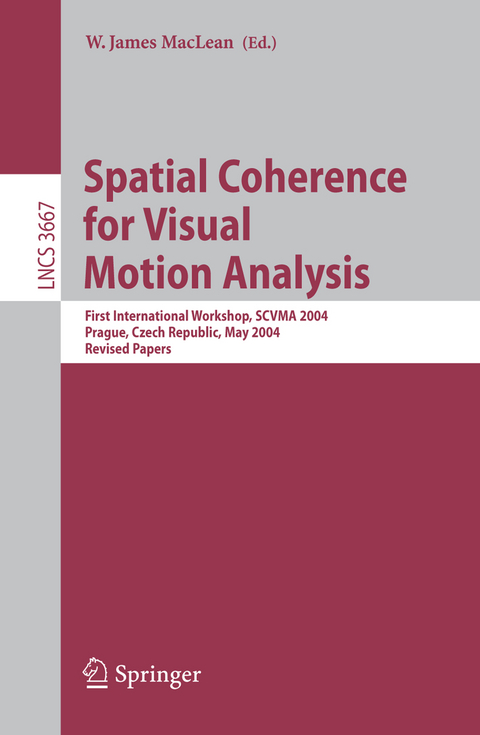
Spatial Coherence for Visual Motion Analysis
First International Workshop, SCVMA 2004, Prague, Czech Republic, May 15, 2004, Revised Papers
Seiten
2006
|
2006
Springer Berlin (Verlag)
978-3-540-32533-8 (ISBN)
Springer Berlin (Verlag)
978-3-540-32533-8 (ISBN)
Motionanalysisisacentralproblemincomputervision,andthepasttwodecades have seen important advances in this ?eld. However, visual motion is still often considered on a pixel-by-pixel basis, even though this ignores the fact that image regions corresponding to a single object usually undergo motion that is highly correlated. Further, it is often of interest to accurately measure the boundaries of moving regions. In the case of articulated motion, especially human motion, discovering motion boundaries is non-trivial but an important task nonetheless. Another related problem is identifying and grouping multiple disconnected - gions moving with similar motions, such as a ?ock of geese. Early approaches focused on measuring motion of either the boundaries or the interior, but s- dom both in unison. For several years now, attempts have been made to include spatial coherence terms into algorithms for 2- and 3-D motion recovery, as well as motion boundary estimation. This volume is a record of papers presented at the First International Wo- shop on Spatial Coherence for Visual Motion Analysis, held May 15th, 2004 in Prague, in conjunction with the European Conference on Computer Vision (LNCS 3021-4). The workshop examined techniques for integrating spatial - herence constraints during motion analysis of image sequences. The papers were revised after the workshop to allow for incorporation of feedback from the workshop.
2D Motion Description and Contextual Motion Analysis: Issues and New Models.- Structure from Periodic Motion.- 3D SSD Tracking from Uncalibrated Video.- Comparison of Edge-Driven Algorithms for Model-Based Motion Estimation.- On the Relationship Between Image and Motion Segmentation.- Motion Detection Using Wavelet Analysis and Hierarchical Markov Models.- Segregation of Moving Objects Using Elastic Matching.- Local Descriptors for Spatio-temporal Recognition.- A Generative Model of Dense Optical Flow in Layers.- Analysis and Interpretation of Multiple Motions Through Surface Saliency.- Dense Optic Flow with a Bayesian Occlusion Model.
| Erscheint lt. Verlag | 30.3.2006 |
|---|---|
| Reihe/Serie | Image Processing, Computer Vision, Pattern Recognition, and Graphics | Lecture Notes in Computer Science |
| Zusatzinfo | IX, 141 p. |
| Verlagsort | Berlin |
| Sprache | englisch |
| Maße | 155 x 235 mm |
| Gewicht | 520 g |
| Themenwelt | Informatik ► Grafik / Design ► Digitale Bildverarbeitung |
| Schlagworte | 3D • 3d imaging • algorithm • Algorithm analysis and problem complexity • algorithms • classification • Cognition • computer vision • Image Analysis • image sequence • motion detection • Motion Estimation • multiple motion detection • Neural networks • Object recognition • pattern recognition • Segmentation • spatio-temporal recognition • Stereo Vision • video analysis |
| ISBN-10 | 3-540-32533-6 / 3540325336 |
| ISBN-13 | 978-3-540-32533-8 / 9783540325338 |
| Zustand | Neuware |
| Haben Sie eine Frage zum Produkt? |
Mehr entdecken
aus dem Bereich
aus dem Bereich
Modelle für 3D-Druck und CNC entwerfen
Buch | Softcover (2022)
dpunkt (Verlag)
34,90 €
alles zum Drucken, Scannen, Modellieren
Buch | Softcover (2024)
Markt + Technik Verlag
24,95 €


